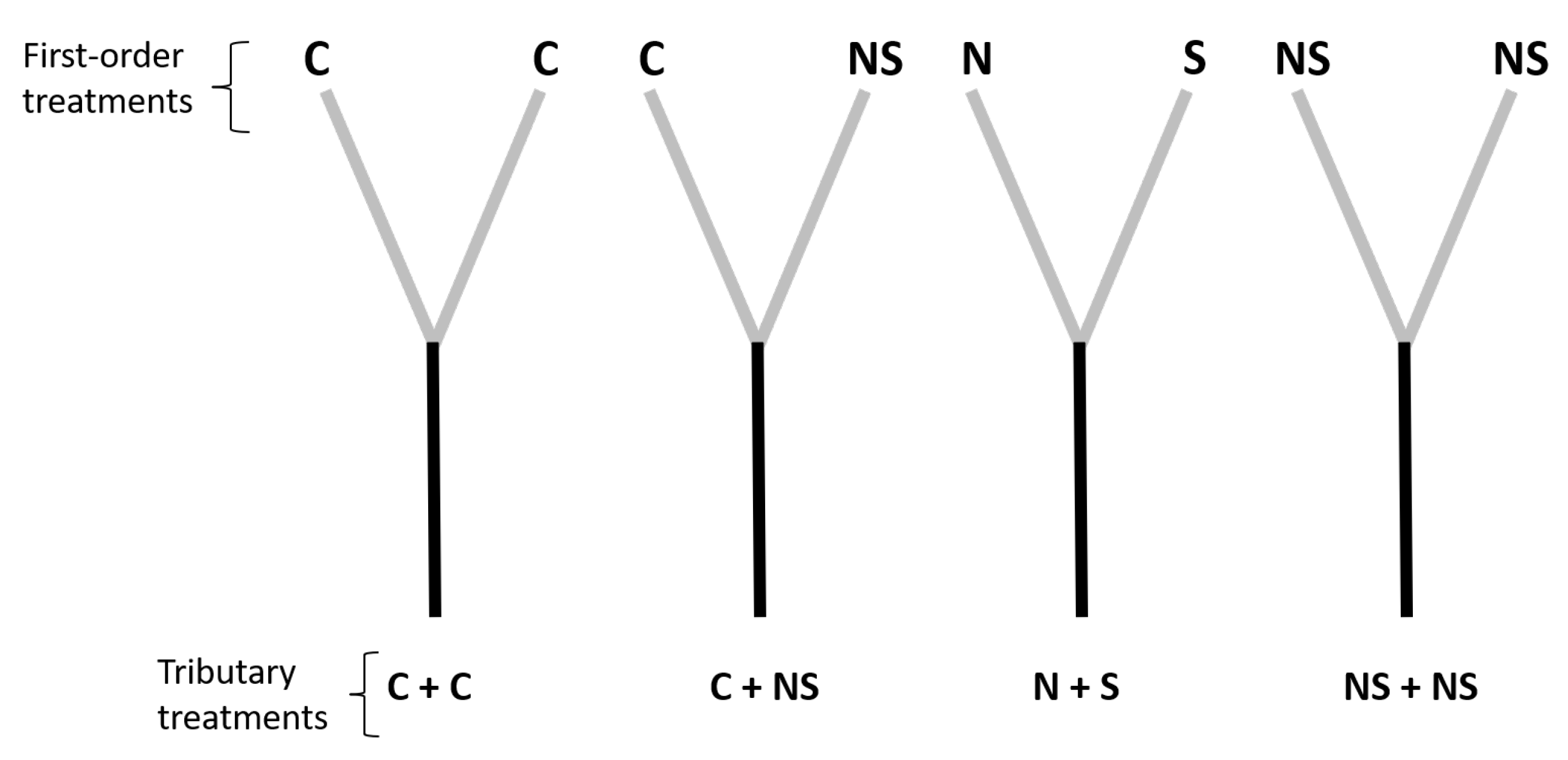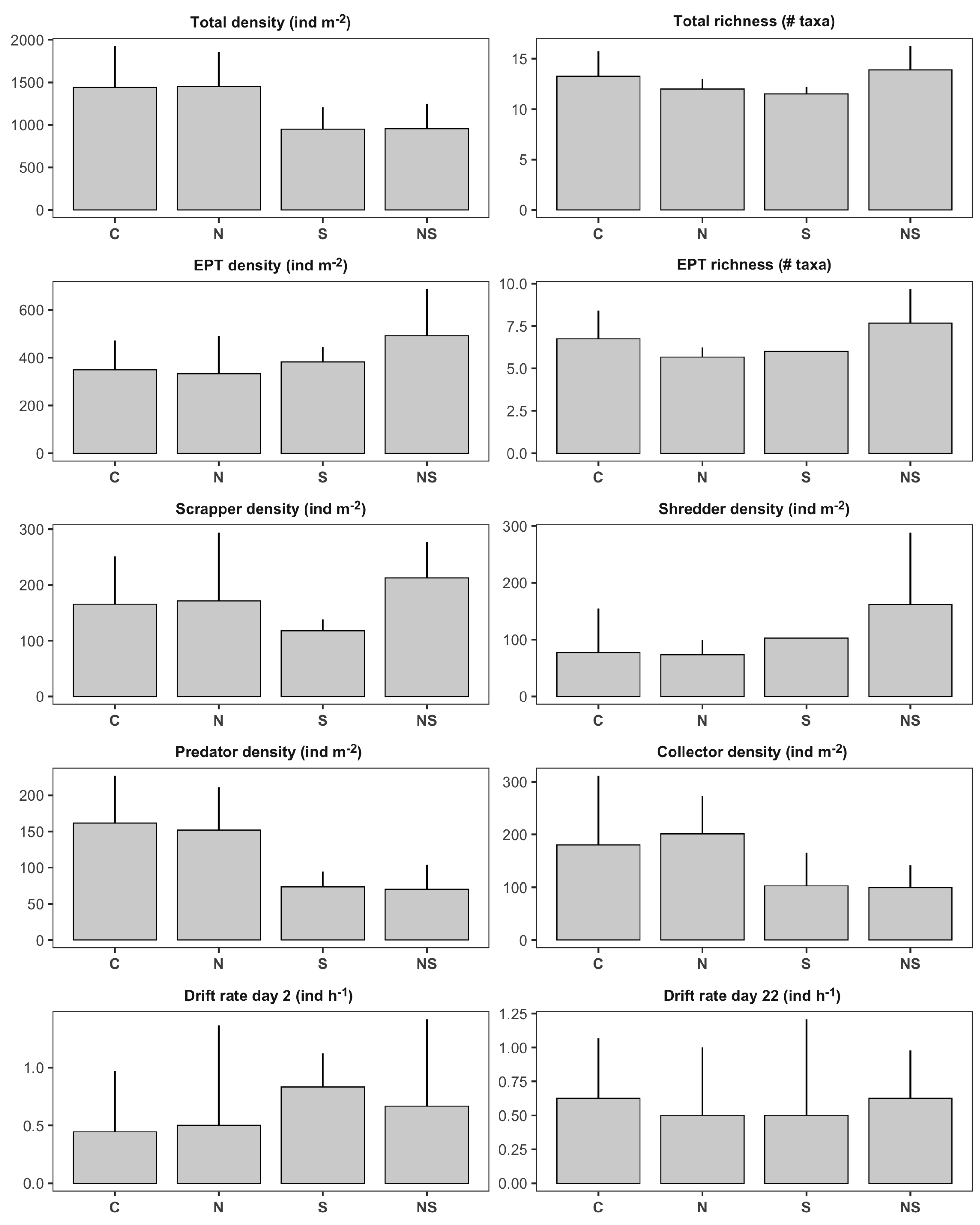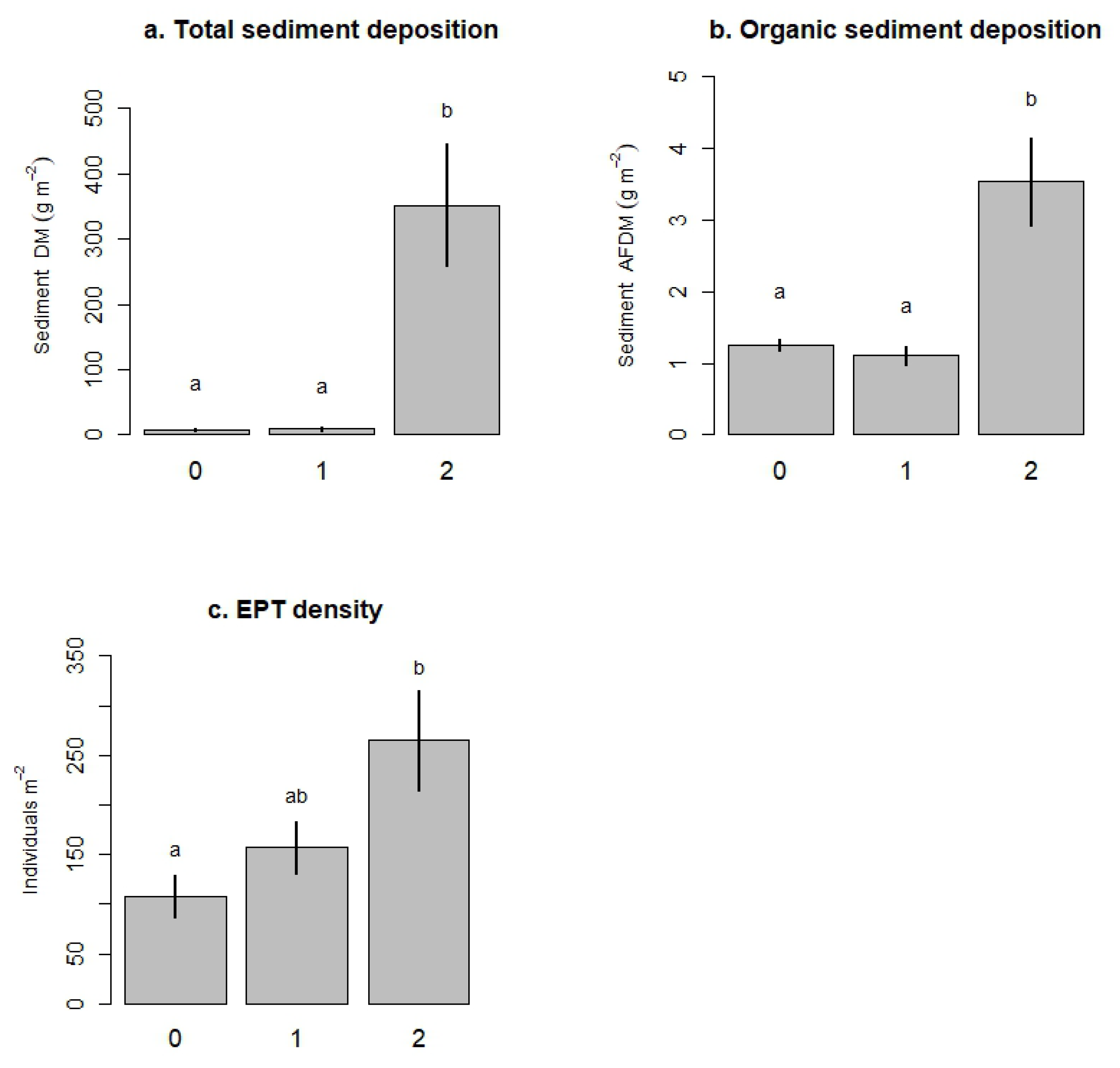Multiple-Stressor Interactions in Tributaries Alter Downstream Ecosystems in Stream Mesocosm Networks
Abstract
1. Introduction
2. Materials and Methods
2.1. Experimental Design
2.2. Response Variables
2.3. Data Analysis
3. Results
3.1. Stressor Effects on First-Order Channels
3.2. Stressor Effects on Second-Order Channels
4. Discussion
4.1. Stressors Altered Invertebrate Communities and Ecosystem Function in First-Order Channels
4.2. Tributaries Influenced Downstream Ecosystems through Dispersal of Sensitive Taxa
4.3. Implications
Author Contributions
Funding
Acknowledgments
Conflicts of Interest
Appendix A

References
- Benda, L.; Poff, N.L.; Miller, D.; Dunne, T.; Reeves, G.; Pess, G.; Pollock, M. The network dynamics hypothesis: How channel networks structure riverine habitats. BioScience 2004, 54, 413–427. [Google Scholar] [CrossRef]
- Campbell Grant, E.H.; Lowe, W.H.; Fagan, W.F. Living in the branches: Population dynamics and ecological processes in dendritic networks. Ecol. Lett. 2007, 10, 165–175. [Google Scholar] [CrossRef]
- Fisher, S.G. Creativity, idea generation, and the functional morphology of streams. J. N. Am. Benthol. Soc. 1997, 16, 305–318. [Google Scholar] [CrossRef]
- Allan, J.D.; Castillo, M.M. Stream Ecology, Structure and Function of Running Waters; Springer: Dordrecht, The Netherlands, 2007; p. 436. [Google Scholar]
- Gomi, T.; Sidle, R.C.; Richardson, J.S. Understanding processes and downstream linkages of headwater systems. BioScience 2002, 52, 905–915. [Google Scholar] [CrossRef]
- Brown, B.L.; Swan, C.M.; Auerbach, D.A.; Campbell Grant, E.H.; Hitt, N.P.; Maloney, K.O.; Patrick, C. Metacommunity theory as a multispecies, multiscale framework for studying the influence of river network structure on riverine communities and ecosystems. J. N. Am. Benthol. Soc. 2011, 30, 310–327. [Google Scholar] [CrossRef]
- Loreau, M.; Mouquet, N.; Holt, R.D. Meta-ecosystems: A theoretical framework for a spatial ecosystem ecology. Ecol. Lett. 2003, 6, 673–679. [Google Scholar] [CrossRef]
- Tomscha, S.A.; Gergel, S.E.; Tomlinson, M.J. The spatial organization of ecosystem services in river-floodplains. Ecosphere 2017, 8. [Google Scholar] [CrossRef]
- Wipfli, M.S.; Richardson, J.S.; Naiman, R.J. Ecological linkages between headwaters and downstream ecosystems: Transport of organic matter, invertebrates, and wood down headwaters channels. J. Am. Water Resour. Assoc. 2007, 43, 72–85. [Google Scholar] [CrossRef]
- Allan, J.D. Landscapes and riverscapes: The influence of land use on stream ecosystems. Annu. Rev. Ecol. Evol. Syst. 2004, 35, 257–284. [Google Scholar] [CrossRef]
- Riseng, C.M.; Wiley, M.J.; Black, R.W.; Munn, M.D. Impacts of agricultural land use on biological integrity: A causal analysis. Ecol. Appl. 2011, 21, 3128–3146. [Google Scholar] [CrossRef]
- Woodward, G.; Gessner, M.O.; Giller, P.S.; Gulis, V.; Hladyz, S.; Lecerf, A.; Malmqvist, B.; McKie, B.G.; Tiegs, S.D.; Cariss, H.; et al. Continental-scale effects of nutrient pollution on stream ecosystem functioning. Science 2012, 336, 1438–1440. [Google Scholar] [CrossRef] [PubMed]
- Wagenhoff, A.; Lange, K.; Townsend, C.R.; Matthaei, C.D. Patterns of benthic algae and cyanobacteria along twin-stressor gradients of nutrients and fine sediment: A stream mesocosm experiment. Freshw. Biol. 2013, 58, 1849–1863. [Google Scholar] [CrossRef]
- García, L.; Pardo, I.; Cross, W.F.; Richardson, J.S. Moderate nutrient enrichment affects algal and detritus pathways differently in a temperate rainforest stream. Aquat. Sci. 2017, 79, 941–952. [Google Scholar] [CrossRef]
- Wood, P.J.; Armitage, P.D. Biological effects of fine sediment in the lotic environment. Environ. Manag. 1997, 21, 203–217. [Google Scholar]
- Matthaei, C.D.; Weller, F.; Kelly, D.W.; Townsend, C.R. Impacts of fine sediment addition to tussock, pasture, dairy and deer farming streams in New Zealand. Freshw. Biol. 2006, 51, 2154–2172. [Google Scholar] [CrossRef]
- Wagenhoff, A.; Townsend, C.R.; Phillips, N.; Matthaei, C.D. Subsidy-stress and multiple-stressor effects along gradients of deposited fine sediment and dissolved nutrients in a regional set of streams and rivers. Freshw. Biol. 2011, 56, 1916–1936. [Google Scholar] [CrossRef]
- Louhi, P.; Richardson, J.S.; Muotka, T. Sediment addition reduces the importance of predation on ecosystem functions in experimental stream channels. Can. J. Fish. Aquat. Sci. 2017, 74, 32–40. [Google Scholar] [CrossRef]
- Matthaei, C.D.; Piggott, J.J.; Townsend, C.R. Multiple stressors in agricultural streams: Interactions among sediment addition, nutrient enrichment and water abstraction. J. Appl. Ecol. 2010, 47, 639–649. [Google Scholar] [CrossRef]
- Piggott, J.J.; Lange, K.; Townsend, C.R.; Matthaei, C.D. Multiple stressors in agricultural streams: A mesocosm study of interactions among raised water temperature, sediment addition and nutrient enrichment. PLoS ONE 2012, 7, 1–14. [Google Scholar] [CrossRef]
- Wagenhoff, A.; Townsend, C.R.; Matthaei, C.D. Macroinvertebrate responses along broad stressor gradients of deposited fine sediment and dissolved nutrients: A stream mesocosm experiment. J. Appl. Ecol. 2012, 49, 892–902. [Google Scholar] [CrossRef]
- Chará-Serna, A.M.; Richardson, J.S. Chlorpyrifos interacts with other agricultural stressors to alter stream communities in laboratory microcosms. Ecol. Appl. 2018, 28, 162–176. [Google Scholar] [CrossRef] [PubMed]
- Chará-Serna, A.; Epele, L.; Morrissey, C.; Richardson, J. Nutrients and sediment modify the impacts of a neonicotinoid insecticide on freshwater community structure and ecosystem functioning. Sci. Total Environ. 2019, 692, 1291–1303. [Google Scholar] [CrossRef] [PubMed]
- Freeman, M.C.; Pringle, C.M.; Jackson, C.R. Hydrologic connectivity and the contribution of stream headwaters to ecological integrity at regional scales. J. Am. Water Resour. Assoc. 2007, 43, 5–14. [Google Scholar] [CrossRef]
- Rasmussen, J.J.; Wiberg-Larsen, P.; Baattrup-Pedersen, A.; Monberg, R.J.; Kronvang, B. Impacts of pesticides and natural stressors on leaf litter decomposition in agricultural streams. Sci. Total Environ. 2012, 416, 148–155. [Google Scholar] [CrossRef]
- Schneider, S.C.; Kahlert, M.; Kelly, M.G. Interactions between pH and nutrients on benthic algae in streams and consequences for ecological status assessment and species richness patterns. Sci. Total Environ. 2013, 444, 73–84. [Google Scholar] [CrossRef][Green Version]
- Patrick, C.J.; Fernandez, D.H. The β-richness of two detritivore caddisflies affects fine organic matter export. Oecologia 2013, 172, 1105–1115. [Google Scholar] [CrossRef]
- Bernhardt, E.S.; Likens, G.E.; Hall, R.O.; Buso, D.C.; Fisher, S.G.; Burton, T.M.; Meyer, J.L.; Mcdowell, W.H.; Mayer, M.S.; Bowden, W.B.; et al. Ca not see the forest for the stream? In-stream processing and terrestrial nitrogen exports. BioScience 2005, 55, 219–230. [Google Scholar] [CrossRef]
- Richardson, J.S. Seasonal food limitation of detritivores in a montane stream: An experimental test. Ecology 1991, 72, 873–887. [Google Scholar] [CrossRef]
- Lecerf, A.; Richardson, J.S. Assessing the functional importance of large-bodied invertebrates in experimental headwater streams. Oikos 2011, 120, 950–960. [Google Scholar] [CrossRef]
- Townsend, C.R.; Uhlmann, S.S.; Matthaei, C.D. Individual and combined responses of stream ecosystems to multiple stressors. J. Appl. Ecol. 2008, 45, 1810–1819. [Google Scholar] [CrossRef]
- Kiffney, P.M.; Richardson, J.S. Interactions among nutrients, periphyton, and invertebrate and vertebrate (Ascaphus truei) grazers in experimental channels. Copeia 2001, 2, 422–429. [Google Scholar] [CrossRef]
- APHA. Standard Methods for the Examination of Water and Wastewaters, 21th ed.; American Public Health Association: Washington, DC, USA, 2005. [Google Scholar]
- Merritt, R.W.; Cummins, K.W. An Introduction to the Aquatic Insects of North America, 3rd ed.; Kendall/Hunt Pub. Co.: Dubuque, IA, USA, 1996; p. 862. [Google Scholar]
- Hauer, F.R.; Lamberti, G.A. Methods in Stream Ecology; Academic Press: Burlington, MA, USA, 2007; p. 894. [Google Scholar]
- Nakagawa, S.; Cuthill, I.C. Effect size, confidence interval and statistical significance: A practical guide for biologists. Biol. Rev. 2007, 82, 591–605. [Google Scholar] [CrossRef]
- Gurevitch, J.; Hedges, L.V. Meta-analysis: Combining the results of independent experiments. In Design and Analysis of Ecological Experiments; Scheiner, S., Gurevitch, J., Eds.; Oxford University Press: Cary, NC, USA, 2006; pp. 347–369. [Google Scholar]
- Jackson, M.C.; Loewen, C.J.G.; Vinebrooke, R.D.; Chimimba, C.T. Net effects of multiple stressors in freshwater ecosystems: A meta-analysis. Glob. Chang. Biol. 2016, 22, 180–189. [Google Scholar] [CrossRef] [PubMed]
- Rosemond, A.D.; Benstead, J.P.; Bumpers, P.M.; Gulis, V.; Kominoski, J.S.; Manning, D.W.P.; Suberkropp, K.; Wallace, J.B. Experimental nutrient additions accelerate terrestrial carbon loss from stream ecosystems. Science 2015, 347, 318–321. [Google Scholar] [CrossRef]
- Naman, S.M.; Rosenfeld, J.S.; Richardson, J.S. Causes and consequences of invertebrate drift in running waters: From individuals to populations and trophic fluxes. Can. J. Fish. Aquat. Sci. 2016, 73, 1292–1305. [Google Scholar] [CrossRef]
- Hammock, B.G.; Wetzel, W.C. The relative importance of drift causes for stream insect herbivores across a canopy gradient. Oikos 2013, 122, 1586–1593. [Google Scholar] [CrossRef]
- O’Callaghan, P.; Jocqué, M.; Kelly-Quinn, M. Nutrient- and sediment-induced macroinvertebrate drift in Honduran cloud forest streams. Hydrobiologia 2015, 758, 75–86. [Google Scholar] [CrossRef]
- Naman, S.M.; Rosenfeld, J.S.; Richardson, J.S.; Way, J.L. Species traits and channel architecture mediate flow disturbance impacts on invertebrate drift. Freshw. Biol. 2017, 62, 340–355. [Google Scholar] [CrossRef]
- Piggott, J.J.; Salis, R.K.; Lear, G.; Townsend, C.R.; Matthaei, C.D. Climate warming and agricultural stressors interact to determine stream macroinvertebrate community dynamics. Glob. Chang. Biol. 2015, 21, 1887–1906. [Google Scholar] [CrossRef]
- Connolly, N.M.; Pearson, R.G. The effect of fine sedimentation on tropical stream macroinvertebrate assemblages: A comparison using flow-through artificial stream channels and recirculating mesocosms. Hydrobiologia 2007, 592, 423–438. [Google Scholar] [CrossRef]
- Young, R.G.; Matthaei, C.D.; Townsend, C.R. Organic matter breakdown and ecosystem metabolism: Functional indicators for assessing river ecosystem health. J. N. Am. Benthol. Soc. 2008, 27, 605–625. [Google Scholar] [CrossRef]
- Tank, J.L.; Rosi-Marshall, E.J.; Griffiths, N.A.; Entrekin, S.A.; Stephen, M.L. A review of allochthonous organic matter dynamics and metabolism in streams. J. N. Am. Benthol. Soc. 2010, 29, 118–146. [Google Scholar] [CrossRef]
- Danger, M.; Cornut, J.; Elger, A.; Chauvet, E. Effects of burial on leaf litter quality, microbial conditioning and palatability to three shredder taxa. Freshw. Biol. 2012, 57, 1017–1030. [Google Scholar] [CrossRef]
- Piggott, J.J.; Niyogi, D.K.; Townsend, C.R.; Matthaei, C.D. Multiple stressors and stream ecosystem functioning: Climate warming and agricultural stressors interact to affect processing of organic matter. J. Appl. Ecol. 2015, 52, 1126–1134. [Google Scholar] [CrossRef]
- Yule, C.M.; Gan, J.Y.; Jinggut, T.; Lee, K.V. Urbanization affects food webs and leaf-litter decomposition in a tropical stream in Malaysia. Freshw. Sci. 2015, 34, 702–715. [Google Scholar] [CrossRef]








| N | S | N*S | |||||
|---|---|---|---|---|---|---|---|
| Response Variables | df | F | P | F | P | F | P |
| Habitat variables | |||||||
| Sediment dry mass | 1, 21 | 0.592 | 0.450 | 114.206 | <0.0001 | 1.061 | 0.315 |
| Sediment AFDM | 1, 21 | 2.218 | 0.151 | 11.349 | 0.003 | 2.284 | 0.146 |
| Sediment % organic | 1, 21 | 0.984 | 0.333 | 19.115 | <0.0001 | 0.823 | 0.375 |
| Benthic invertebrates | |||||||
| Total density | 1, 18 | 0.002 | 0.966 | 5.975 | 0.025 | 0.000 | 0.988 |
| Total richness | 1, 18 | 0.240 | 0.630 | 0.004 | 0.953 | 2.452 | 0.135 |
| EPT density | 1, 18 | 0.320 | 0.578 | 1.343 | 0.262 | 0.576 | 0.458 |
| EPT richness | 1, 18 | 0.110 | 0.744 | 0.504 | 0.487 | 2.440 | 0.136 |
| Scraper density | 1, 18 | 1.483 | 0.239 | 0.007 | 0.934 | 1.144 | 0.299 |
| Shredder density | 1, 18 | 0.298 | 0.592 | 1.270 | 0.275 | 0.381 | 0.545 |
| Predator density | 1, 18 | 0.062 | 0.806 | 10.492 | 0.005 | 0.016 | 0.902 |
| Collector density | 1, 18 | 0.035 | 0.854 | 3.585 | 0.074 | 0.065 | 0.801 |
| drift rate day 2 | 1, 18 | 0.033 | 0.857 | 0.828 | 0.374 | 0.132 | 0.720 |
| drift rate day 22 | 1, 18 | 1.769 | 0.205 | 0.087 | 0.773 | 0.023 | 0.881 |
| Ecosystem function | |||||||
| Leaf decomposition | 1, 18 | 2.351 | 0.141 | 2.185 | 0.155 | 8.520 | 0.008 |
| Count Model | Zero-Inflation Model | |||||||
|---|---|---|---|---|---|---|---|---|
| Factor | Estimate | SE | z | P | Estimate | SE | z | P |
| N | 1.735 | 0.307 | 5.650 | <0.0001 | 3.302 | 154.596 | 0.021 | 0.983 |
| S | −0.619 | 0.307 | −2.060 | 0.044 | −2.689 | 154.596 | −0.017 | 0.986 |
| N*S | −0.015 | 0.307 | −0.034 | 0.973 | 2.969 | 154.596 | 0.019 | 0.985 |
| Cumulative | Single | t-Test | ||||
|---|---|---|---|---|---|---|
| Response Variable | Mean | SD | Mean | SD | t | P |
| Habitat variables | ||||||
| Sediment dry mass (g m−2) | 133.53 | 113.53 | 502.79 | 249.26 | −2.4 | 0.076 |
| Sediment AFDM (g m−2) | 16.18 | 3.68 | 23.82 | 15.29 | −0.6 | 0.659 |
| Nitrate (μg L−1) | 76.5 | 0.5 | 80.5 | 0.5 | −1.1 | 0.446 |
| Benthic invertebrates | ||||||
| Total density (ind m−2) | 1083.3 | 770.1 | 823.6 | 420.3 | 0.5 | 0.642 |
| Total richness (taxa per mesocosm) | 11.3 | 3.1 | 11.7 | 2.3 | −0.2 | 0.888 |
| EPT density (ind m−2) | 156.9 | 44.9 | 254.9 | 37.0 | −2.9 | 0.045 |
| EPT richness (taxa per mesocosm) | 3.3 | 0.6 | 6.0 | 1.0 | −4.0 | 0.025 |
| Response Variable | Mean | SD | Mean | SD | t | P |
| Scraper density (ind m−2) | 44.1 | 29.4 | 122.5 | 44.9 | −2.5 | 0.074 |
| Shredder density (ind m−2) | 39.2 | 30.6 | 58.8 | 58.8 | −0.5 | 0.644 |
| Predator density (ind m−2) | 78.4 | 55.7 | 39.2 | 22.5 | 1.1 | 0.350 |
| Collector density (ind m−2) | 142.1 | 51.6 | 122.5 | 17.0 | 0.6 | 0.586 |
| Drift rate day 2 (ind h−1) | 1.3 | 1.2 | 1.3 | 0.3 | 0.0 | 0.976 |
| Drift rate day 22 (ind h−1) | 0.3 | 0.1 | 0.6 | 0.1 | −3.2 | 0.123 |
| Ecosystem function | ||||||
| Leaf decomposition (g AFDM lost) | 0.5 | 0.1 | 0.7 | 0.1 | −1.8 | 0.140 |
| Stress Level | |||
|---|---|---|---|
| Response Variables | df | F | P |
| Habitat variables | |||
| Sediment dry mass | 2, 6 | 19.024 | 0.003 |
| Sediment AFDM | 2, 6 | 13.852 | 0.006 |
| Sediment % organic | 2, 6 | 2.113 | 0.202 |
| Nitrate | 2, 6 | 0.106 | 0.901 |
| Benthic invertebrates | |||
| Total density | 2, 6 | 1.344 | 0.329 |
| Total richness | 2, 6 | 4.167 | 0.081 |
| EPT density | 2, 6 | 5.187 | 0.049 |
| EPT richness | 2, 6 | 1.716 | 0.232 |
| Scraper density | 2, 6 | 1.972 | 0.220 |
| Shredder density | 2, 6 | 2.197 | 0.192 |
| Predator density | 2, 6 | 1.839 | 0.238 |
| Collector density | 2, 6 | 0.736 | 0.518 |
| Drift rate day 2 | 2, 5 | 0.299 | 0.754 |
| Drift rate day 22 | 2, 6 | 1.760 | 0.264 |
| Ecosystem function | |||
| Leaf decomposition | 2, 6 | 0.300 | 0.751 |
Publisher’s Note: MDPI stays neutral with regard to jurisdictional claims in published maps and institutional affiliations. |
© 2021 by the authors. Licensee MDPI, Basel, Switzerland. This article is an open access article distributed under the terms and conditions of the Creative Commons Attribution (CC BY) license (https://creativecommons.org/licenses/by/4.0/).
Share and Cite
Chará-Serna, A.M.; Richardson, J.S. Multiple-Stressor Interactions in Tributaries Alter Downstream Ecosystems in Stream Mesocosm Networks. Water 2021, 13, 1194. https://doi.org/10.3390/w13091194
Chará-Serna AM, Richardson JS. Multiple-Stressor Interactions in Tributaries Alter Downstream Ecosystems in Stream Mesocosm Networks. Water. 2021; 13(9):1194. https://doi.org/10.3390/w13091194
Chicago/Turabian StyleChará-Serna, Ana M., and John S. Richardson. 2021. "Multiple-Stressor Interactions in Tributaries Alter Downstream Ecosystems in Stream Mesocosm Networks" Water 13, no. 9: 1194. https://doi.org/10.3390/w13091194
APA StyleChará-Serna, A. M., & Richardson, J. S. (2021). Multiple-Stressor Interactions in Tributaries Alter Downstream Ecosystems in Stream Mesocosm Networks. Water, 13(9), 1194. https://doi.org/10.3390/w13091194






